Some information on the Processionary Pine Caterpillars currently a big pain in the backside in our area. There are a growing number of incidents involving pests in contact with these pets in the Languedoc - my neighbour has them in her trees disposes of the nests by burning them. I'm dreading seeing them in my garden as it means keeping the kids away from them as they can cause serious allergic reactions and both myself and my littlest one are very reactive to bites. They are extremely dangerous to inquisitive dogs and cats. One problem noted by people in my village was that many of the gardens of second home owners have these nest and they are untreated as the owners don't tend to come out at the active time of the year. So I wanted to share this for everyone to be aware that they are a pest under high surveillance and please do be careful and if you have pine trees please do control the nests.
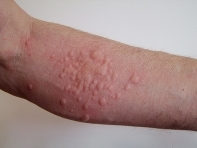
Pine processionary moth (PPM) larvae (caterpillars) feed on the needles of pine trees and some other conifer tree species. In large numbers they can severely defoliate trees, weakening them and making them more susceptible to attack by other pests or diseases, or to environmental stress caused by drought or excessive moisture. PPM, like its close relative the oak processionary moth (OPM), gets its name from its distinctive habit of moving about in nose-to-tail processions.
Like OPM, PPM caterpillars represent a public health hazard because they have thousands of hairs which contain an urticating, or irritating, protein called thaumetopoein. These hairs can be blown by the wind into contact with people and animals, resulting in painful skin irritations and rashes and, in some cases, allergic reactions in some people and animals.
Distribution
Possibly as a response to climate change, PPM has been expanding its range north through France since the 1990s, and is now breeding near Paris. Long-distance movement is thought to be associated with pupae carried in the growing medium or soil of infested plants. Climate change is thought to be responsible for the success of the moth's establishment once it arrives in regions north of its natural range.
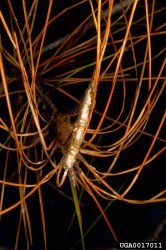
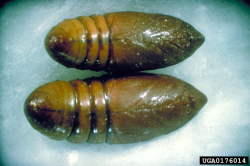
Pupae can remain in the soil for up to three years before the larvae emerge. This is the pathway by which it is believed that PPM was moved to the Paris area.
b. Natural Spread
Adults of both sexes can fly, and natural dispersal depends on the flight capacity of female moths, which is lower than that of males. Average female flying distance is 1.7km, with a maximum recorded of 10.5 km. This is consistent with the rate of spread recorded in the south of the Paris Basin, which has been reported as 5.6 km per year. Based on the moth's current known distribution, the risk of natural spread into the UK is still low compared to movement with plants for planting.
Susceptible trees
Pine trees (trees of the genus Pinus) are most susceptible to attack, with the following species being particularly susceptible: Austrian pine (Pinus nigra), Aleppo pine (P. halepensis), Canary Island pine (P. canariensis), lodgepole pine (P. contorta), Maritime pine (P. pinaster), Monterey or radiata pine (P. radiata), Scots pine (P. sylvestris) and stone pine (P. pinea). Other recorded hosts include the Atlas cedar (Cedrus atlantica) and European larch (Larix decidua).
Symptoms
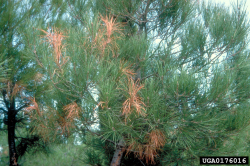
Defoliation of needles (right) is the main symptom of PPM attack displayed by the tree itself. Complete defoliation of needles can occur where there is a high level of infestation. Otherwise the nests formed by the caterpillars in January are the most obvious signs of the moth being present. Caterpillars feed at night during the winter, when fewer people are visiting woodlands.
Life-cycle
The life-cycle of PPM is different from OPM's. PPM caterpillars overwinter in tent-like nests high in pine trees, and form processions on the ground in early spring before pupating in the soil until late summer, when they emerge as adult moths. This pupal stage can, however, remain dormant, extending the life cycle over two years.
The adult moths live for only about a day in the summer, during which time they mate and lay eggs in pine trees.
PPM larvae, or caterpillars, hatch in autumn from the eggs laid in the summer, and begin feeding on the trees' needles in autumn.
Identification
Caterpillars: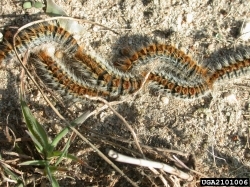
However:
- OPM caterpillars often form a wedge-shaped procession, with one leader and subsequent rows containing several larvae
- PPM caterpillars are more likely to form a single line of nose-to-tail larvae
- OPM caterpillars have very long, white hairs which contrast markedly with other, shorter hairs
- PPM caterpillars are instead covered with dense clumps of hairs with less variation in length
- PPM caterpillars are most likely to be seen in winter and early spring
- OPM larvae are most likely to be seen in summer
- PPM caterpillars are most likely to be found in pine trees
- OPM caterpillars are most likely to be found in oak trees
Moths: 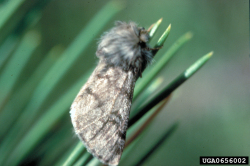
Nests: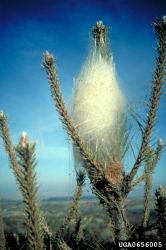
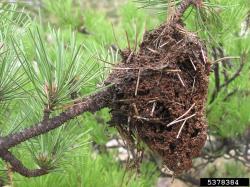
The nests can become damaged and discoloured over time (right).
Preferred trees: PPM is most likely to be found in pine trees, while OPM is most likely to be found in oak trees.
Health precautions
In the affected areas take some simple precautions to help minimise the health risks to you and your pets and livestock:
DO NOT:
- touch or approach nests or caterpillars
- let children touch or approach nests or caterpillars
- let animals touch or approach nests or caterpillars
- try removing nests or caterpillars yourself
DO:
- teach children not to touch or approach the nests or caterpillars
- train or restrain pets from touching or approaching them;
- see a pharmacist for relief from skin or eye irritations after possible OPM contact
- call a doctor if you think you or someone you care for has had a serious allergic reaction
- see a vet if you think your pet or livestock has been seriously affected
- call in a pest control expert to remove infestations in your own trees
info from forestry.gov.uk www.inra.fr